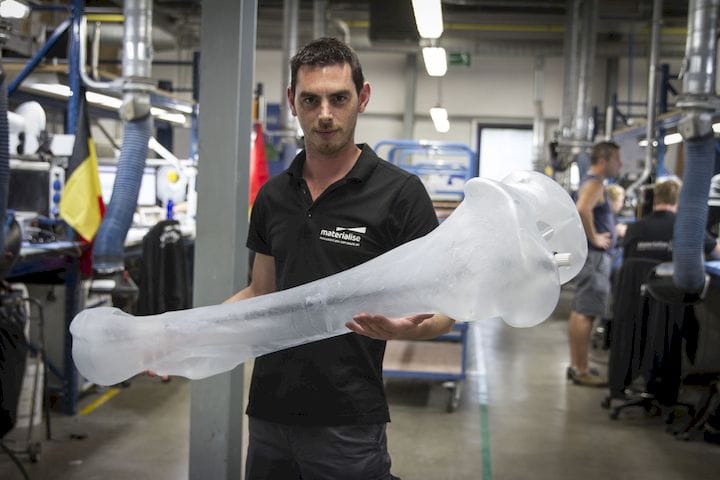![One of 300+ 3D printed bones for a massive Mammoth replica [Source: i.materialise]](https://fabbaloo.com/wp-content/uploads/2020/05/image-asset_img_5eb0a0597738d.jpg)
i.materialise printed a very large sculpture, and in the process revealed some interesting engineering practices.
The Belgian 3D print service was asked to 3D print a fully life sized skeleton replica of the extinct Woolly Mammoth for the city museum of Lier in Belgium. Not only was this a Mammoth, it was a mammoth 3D printing project, perhaps one of the largest ever attempted.
![Some of the part inventory for the Mammoth 3D printing project [Source: i.materialise]](https://fabbaloo.com/wp-content/uploads/2020/05/image-asset_img_5eb0a059d9e4c.jpg)
The project’s scale is ridiculous: experts were required to painstakingly 3D scan in great detail more than 300 different actual bones. And as anyone who’s 3D scanned something knows, they then had to spend considerable time fixing and tweaking the scans to make them 3D printable. i.materialise says the total final file size for all the resulting 3D models exceed a huge 21GB. That’s a staggering amount of 3D data!
![Printing Woolly Mammoth tusks on a Mammoth 3D printer [Source: i.materialise]](https://fabbaloo.com/wp-content/uploads/2020/05/image-asset_img_5eb0a05a3cfe7.jpg)
The company says they spent 1259 hours 3D printing the 300+ models on their huge stereolithography machines at a layer size of only 0.1mm. Incidentally, their largest 3D printer is named “Mammoth”. After printing they spray painted the models and treated them to visually appear similar to actual bones dug from the earth.
That’s all terrific, but what was of most interest to me was how they engineered the models, and their approach provides several lessons for others considering 3D printed designs.
![Painting a 3D printed Woolly Mammoth tusk [Source: i.materialise]](https://fabbaloo.com/wp-content/uploads/2020/05/image-asset_img_5eb0a05a90e1f.jpg)
One of their big challenges on this project was weight. The bones would be erected in a lifelike configuration, meaning most bones would have to be supported in a strong manner, sometimes cantilevering over longer distances, as per Mammoth pose. Some parts were over 2m in length, exacerbating the problem. How could they keep the weight down?
If they simply skimped on 3D print material, then some of the larger parts would not be able to support themselves. If they added sufficient material to support themselves, then the parts would become unwieldily heavy.
Their design choice was brilliant: The bones were made with as little 3D print material as possible, basically to form the exterior surface of each bone. Then, inside each bone would be a lightweight, but very strong, carbon fiber armature that actually holds the weight.
If you look very closely at the image at top, you’ll see a slightly dark shadow within the print. This would be a hint of the hidden carbon fiber structure.
These carbon fiber pieces had to fit the sometimes unusual interior forms of each bone, and thus i.materialise chose to 3D print small connector pieces to join them together inside the bones.
The magic of this approach was simply that they recognized that 3D printing is just ONE of many tools that can be used to build objects, and that it is more powerful when combined with other manufacturing techniques.
I have a very strong suspicion that when they were approached by their client, they were asked if they could “3D print a Mammoth”, with the client assuming that it would simply “come out of the printer”. It’s to i.materialise’s credit that they thought outside of the box to come up with this ingenious engineering solution.
And that’s the lesson for 3D print designers reading this piece: 3D printing is not always the whole answer.
Via i.materialise











This week’s selection is a 3D printed Coronavirus!